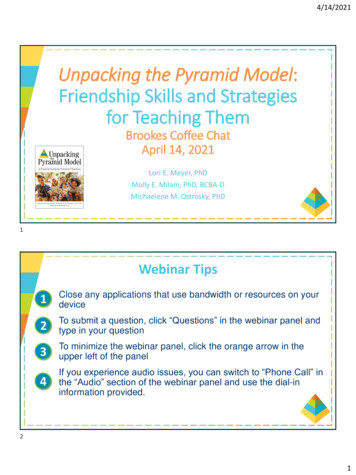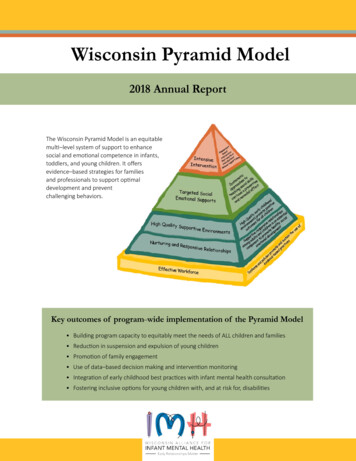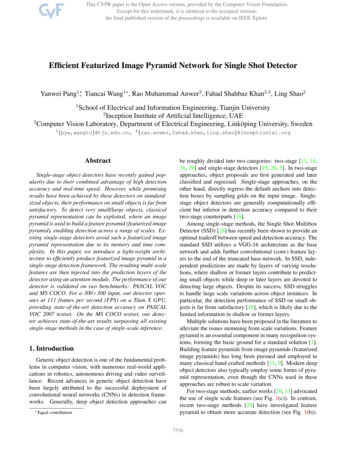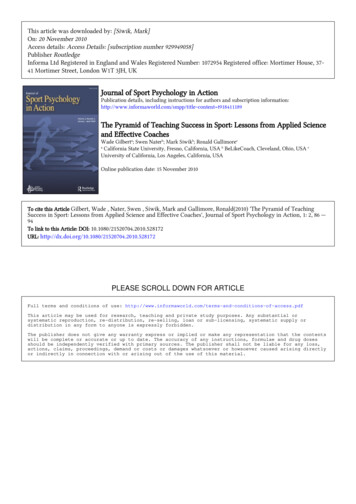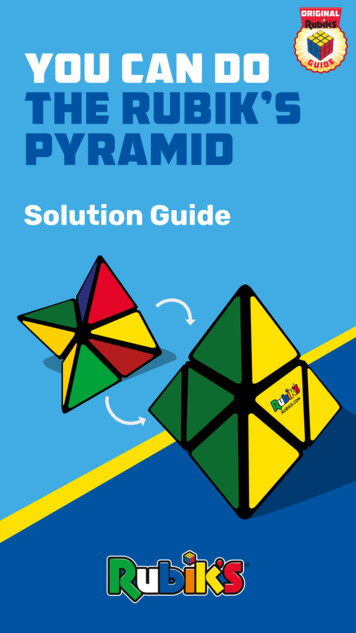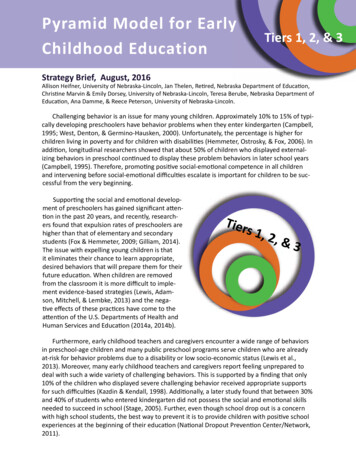
Transcription
Pyramid Model for EarlyChildhood EducationTiers 1, 2, & 3Strategy Brief, August, 2016Allison Heifner, University of Nebraska-Lincoln, Jan Thelen, Retired, Nebraska Department of Education,Christine Marvin & Emily Dorsey, University of Nebraska-Lincoln, Teresa Berube, Nebraska Department ofEducation, Ana Damme, & Reece Peterson, University of Nebraska-Lincoln.Challenging behavior is an issue for many young children. Approximately 10% to 15% of typically developing preschoolers have behavior problems when they enter kindergarten (Campbell,1995; West, Denton, & Germino-Hausken, 2000). Unfortunately, the percentage is higher forchildren living in poverty and for children with disabilities (Hemmeter, Ostrosky, & Fox, 2006). Inaddition, longitudinal researchers showed that about 50% of children who displayed externalizing behaviors in preschool continued to display these problem behaviors in later school years(Campbell, 1995). Therefore, promoting positive social-emotional competence in all childrenand intervening before social-emotional difficulties escalate is important for children to be successful from the very beginning.Supporting the social and emotional development of preschoolers has gained significant attention in the past 20 years, and recently, researchers found that expulsion rates of preschoolers arehigher than that of elementary and secondarystudents (Fox & Hemmeter, 2009; Gilliam, 2014).The issue with expelling young children is thatit eliminates their chance to learn appropriate,desired behaviors that will prepare them for theirfuture education. When children are removedfrom the classroom it is more difficult to implement evidence-based strategies (Lewis, Adamson, Mitchell, & Lembke, 2013) and the negative effects of these practices have come to theattention of the U.S. Departments of Health andHuman Services and Education (2014a, 2014b).Tiers 1,2, &3Furthermore, early childhood teachers and caregivers encounter a wide range of behaviorsin preschool-age children and many public preschool programs serve children who are alreadyat-risk for behavior problems due to a disability or low socio-economic status (Lewis et al.,2013). Moreover, many early childhood teachers and caregivers report feeling unprepared todeal with such a wide variety of challenging behaviors. This is supported by a finding that only10% of the children who displayed severe challenging behavior received appropriate supportsfor such difficulties (Kazdin & Kendall, 1998). Additionally, a later study found that between 30%and 40% of students who entered kindergarten did not possess the social and emotional skillsneeded to succeed in school (Stage, 2005). Further, even though school drop out is a concernwith high school students, the best way to prevent it is to provide children with positive schoolexperiences at the beginning of their education (National Dropout Prevention Center/Network,2011).
Building & SustainingStudent EngagementWhat is the Pyramid Model?The Teaching Pyramid Model, more recently referred to as the Pyramid Model, isa comprehensive, multi-tiered framework ofevidence-based practices that promote thesocial, emotional, and behavioral development of young children (Hemmeter, Ostrosky,& Corso, 2012). The Pyramid Model focuses onpromoting positive behavior and addressingchallenging behavior (Hemmeter et al., 2012).The following strategies are emphasized in theeffective practices: Acknowledging and reinforcing positivechild behavior, Directly teaching social skills, expectations, and behaviors to children relatedto different environments, Monitoring children’s challenging behaviors, and Teaching positive replacement behaviors.This model incorporates the ongoing collectionand use of teacher, classroom, child and familydata for decision-making regarding children’sresponse to intervention, and employs teambased decision making.Pyramid Model for Early Childhood 2Relationship to PBIS and RTI. The PyramidModel is the early childhood model for PositiveBehavior Interventions and Supports (EC-PBIS)and for Response to Intervention (RTI), whichhave been implemented at the K-12 levels (Fox,Carta, Strain, Dunlap, & Hemmeter, 2009). Itis based on the same underlying principles,practices, and strategies as PBIS and RTI, butis implemented and taught in a way that isdevelopmentally appropriate for young children in early care and education programs. It isdesigned as a program-wide intervention andshould be implemented with fidelity to providepositive environments and promote engagement for all children. Fox and Hemmeter (2009)hope that, like PBIS, the Pyramid Model canbe used as a framework for instruction andbehavior management in preschool settings.Overall, researchers say that the focus of a PBISframework in early childhood settings shouldbe on the promotion of social and emotionaldevelopment and the prevention of challenging behavior for all young children (Fox, Dunlap,Hemmeter, Joseph, & Strain, 2003).Applicable ages and programs. Althoughthe Pyramid Model was designed for programs
Building & SustainingStudent EngagementPyramid Model for Early Childhood3serving 3 and 4-year olds, the research-basedstrategies are not limited to use in this agegroup. The practices have been adapted in manystates for use in child care programs and homesfor children birth to age five, and have beenadapted and extended into K-3 classrooms.org/). Both centers are now consolidated underthe umbrella of the national Pyramid ModelConsortium (www.pyramidmodel.org). Theiraim has been to disseminate Pyramid researchand evidence-based teaching practices to earlychildhood programs across the U.S.Establishment of the Pyramid Model. ThePyramid Model was developed in collaboration between two federally funded researchand training centers. These are the Center forthe Social and Emotional Foundations for EarlyLearning (CSEFEL) funded by the federal Office of Head Start and Child Care (www.csefel.vanderbilt.edu), and the Technical AssistanceCenter on Social Emotional Intervention (TACSEI) funded by the federal Office of SpecialEducation Programs (www.challengingbehavior.Underlying Principles of the PyramidModelThe Pyramid Model proposes practices identified through a review of researched strategiesto promote and enhance the social-emotionaldevelopment of children. The practices are organized in a multi-tiered system of support. Themodel employs a “Pyramid” to represent thetiered system of supports (See Figure 1).Figure 1. The Pyramid ModelRetrieved from: es/documents/pyramid model handout.pdf
Building & SustainingStudent EngagementSome of the principles used in the PyramidModel, such as specifying clear expectationsand providing positive reinforcement for appropriate behaviors, are well-known as evidencebased strategies for increasing desired behavior.In addition, the Pyramid Model implementsteacher practices which have been shown tolead to positive social and behavioral outcomesfor young children. Some of these practicesinclude, “actively supporting children’s play,responding to children’s conversations, promoting the communicative attempts of childrenwith language delays and disabilities, providingspecific praise to encourage appropriate behavior, developing positive relationships withchildren and families, and collaborative teamingwith colleagues and other professionals” (Fox &Hemmeter, 2009, p. 6-7).Tiered ApproachThe Pyramid Model describes four tiers ofpractice, adding an underlyingfoundational level, which addresses issues related to theearly childhood workforce andtraining needed to supportthe following tiers. Developing, implementing, andreviewing the foundationallevel is necessary to sustainthe intervention practicesover time. The Pyramid Modelbuilds on a public health approach to provide universalsupports to all children topromote wellness, targetedsupport to those who needadditional help, and intensiveinterventions to those who need them (http://challengingbehavior.fmhi.usf.edu). The tiers ofintervention serve as the framework throughwhich intervention decisions are made. Withineach tier of intervention, research-based teaching practices and supports are outlined for educators to implement in early childhood settings.The tiers of intervention help prioritize the typeand intensity of behavioral interventions thatstudents receive (Fluke & Peterson, 2013).Pyramid Model for Early Childhood4Foundational level. The foundation for allof the practices in the Pyramid Model are thesystems and policies necessary to ensure aworkforce able to adopt and sustain these evidence-based practices. Early care and educationenvironments and teacher/caregiver skills arediverse and vary widely. An effective workforcethat includes well-trained teachers, professionalcollaboration, shared decision-making and positive relationships between teachers, parents,caregivers, and any specialists are essentialto prevent and address challenging behavioracross all settings associated with an individualchild. This is a necessary support system for thethree tiers of intervention to be implementedeffectively and with fidelity.Promotion practices. Universal supports(Tier 1 in K-12 PBIS) promoting the social development of all young children include two levelsof practices: nurturing and responsive relationships and high quality environments.Nurturing and responsive relationships.Nurturing and responsive relationships areimportant for the promotion of social competence (Fox & Hemmeter, 2009). The PyramidModel focuses on positive interactions not onlywith children but also with families, in order toprovide a comfortable space to discuss problem behaviors, if they emerge (Hemmeter etal., 2012). Therefore, decision-making about achild is a collaborative process between care-
Building & SustainingStudent Engagementgivers, parents, and teachers in order to buildrelationships before challenging behaviors arise.Effective teachers develop these relationshipsthrough ongoing communication with parentsand caregivers related to the child.In order to build positive and supportiverelationships with children, it is important forteachers in early childhood settings to havepositive interactions with each child in theirclassroom every day and to focus on acknowledging positive behaviors more than problembehaviors (Fox, et al.,2011). Because earlychildhood settings are typically childrens’ firstintroduction to school, creating a foundationfor building meaningful relationships betweenschools and families may help set childrenup for success later in school (Hemmeter etal., 2006; Sheridan, Knoche & Marvin, 2008).Finally, the Centers for Disease Control andPrevention (CDC) identified stable and nurturingrelationships as an integral component of earlychildhood education that can serve as a “buffer”to promote positive health-related outcomesfor at-risk children (Mendez, Simpson, Alter, &Meyers, 2015).High quality supportive environments. Thesecond component of the promotion practices is to providepredictable and supportiveenvironments for young children. Stegelin (2004) identified seven characteristics ofhigh-quality early childhoodeducation which include: 1)Holistic, 2) Nurturing, 3) Consistent, 4) Hands-on, 5) Stimulating, 6) Exploratory, and 7)Interactive learning across thecurriculum. These environments promote appropriatebehavior through the explicitteaching of rules and expectations. When children aretaught rules and expectations,and have opportunities topractice them, their problembehaviors decrease (Hem-Pyramid Model for Early Childhood 5meter et al., 2012). Hemmeter and colleagues(2012) outline three essential approaches towell-structured environment:1. Implement a consistent schedule: set aroutine where children learn what to do ona day-to-day basis.2. Minimize transition time: have an activity waiting for children who complete atransition quickly so that they are activelyengaged while they wait for their peers(Hemmeter, Fox, & Snyder, 2013).3. Teach classroom routines and expectations:use picture prompts and teacher reminderswhen necessary.Another component of a high-quality environment is reinforcement for positive behavior.Adult attention is important for supporting thegrowth of young children’s social-emotionaldevelopment. For some children, it might be difficult to “catch them being good” because theydisplay challenging behavior often. Good practice suggests that five or more efforts to praisechildren for positive behavior should occurfor every behavior correction a teacher mightmake. Hemmeter and colleagues (2012) suggest setting a timer to beep every two minutesto prompt the teacher or cargiver to acknowl-
Building & SustainingStudent Engagementedge positive child behavior in the classroom.Through acknowledging such behaviors andproviding specific feedback on children’s behaviors, early childhood teachers are promotingsocial-emotional development. Again, becausesome children served in early childhood settingsmay already be at-risk for displaying challengingbehaviors, the promotion practices are criticalto supporting those children’s emotional development as the consistency of practices can buildchildren’s trust in the environment and promotepro-social independence. While most childrenin early childhood settings will respond to thesepromotion practices, some children will needadditional support to be successful.Targeted social emotional supports. Thistier of intervention (Tier 2 in K-12 PBIS) addresses needs of children at risk for social-emotionaldelays, and includes more targeted social andemotional supports for some children. The purpose of this tier is to identify and provide targeted supports to children who show early signsfor developing challenging behavior, but whoare not currently in need of an individual behavior plan. Young children often require adult helpin order to express their emotions appropriately. For some children, it will be necessary toprovide explicit instruction for social emotionalskills that help them to identify their emotions,express their emotions appropriately, initiatePyramid Model for Early Childhood 6and maintain relationships, and use appropriatesocial problem-solving strategies (Hemmeter etal., 2006).In order to effectively do this, a comprehensive and intentional approach to teachsocial skills is recommended. For instance, ateacher can direct activities through introducinga behavior or concept, modeling the behavior,asking the children to rehearse and role-play,prompting the children to use the behavior in asituation, and providing feedback when childrenengage in the desired behavior (Hemmeter etal., 2006). When such an approach is taken,opportunities to practice skills are increasedand progress monitoring takes place more often(Hemmeter et al., 2013). The caregiver can alsoextend these supports to families in order topromote the development of the child’s socialand emotional skills at home. Research in theuse of such family-focused instruction in socialskill learning has repeatedly shown positive results (Jones, Daley, Hutchings, Bywater, & CarinEames, 2008; Webster-Stratton, 1998).Individualized intensive intervention. Thistier of intervention (Tier 3 in K-12 PBIS) includesintensive support for children who have persistent behavior problems and who are not responsive to the previous tiers of environmentalsupport and intervention. In this tier, a team ofpeople meet to develop an individualized behavior plan tosupplement and strengthenthe current support the childis receiving. An individualbehavior plan is developedthrough the collection offunctional assessment data inorder to determine the function or purpose of a child’sbehavior. Functional assessment includes identifyingvariables in the environmentthat affect the child’s behavior. From this data, an intervention can include teachingpositive replacement behaviors that serve the same purpose as the problem behavior
Building & SustainingStudent EngagementPyramid Model for Early Childhood 7(Maag, 2004) and using consequences that do not reinforceproblem behavior (Hemmeteret al., 2013). Once the plan is inplace, data are collected dailyto determine the child’s progress toward intervention goalsand any necessary changes areimplemented to increase progress. A more complete description of this approach is describedin the Prevent-Teach-Reinforcefor Young Children (PTR-YC) –An Early Childhood Model ofIndividualized Positive BehaviorSupport (Dunlap, Lee, Joseph, &Strain, 2015).Individual behavior plans. In order for amulti-tier system of support to be effectivefor young children, a few factors need to beconsidered. First, young children spend theirtime in many different settings in one day(e.g., home, preschool, childcare, etc.), therefore it is necessary to consider the skill level ofcaregivers in every environment the child is inwhen developing an individual behavior plan(Hemmeter et al., 2006). Specifically, whendeveloping an individual behavior plan for achild, the plan must be able to be carried outconsistently in a child care center, preschool,and at home. Not all early childhood teachers or care providers of young children arerequired to be “highly qualified” or meet statedepartment of education teacher certification standards. Lower education levels and/or inadequate training for some staff maymean less knowledge and skill in implementing strategies that support young children’ssocial-emotional development and addressingchallenging behaviors. Therefore, if any individual plan is to be effective, all adults working with the child need to work collaborativelyto ensure consistent implementation.Second, some of the challenging behaviors young children engage in may be developmentally appropriate or expected and/or maybe due to lack of experience in certain socialsituations (Hemmeter et al., 2006). It is impor-tant to determine whether a child’s behavior isdevelopmentally appropriate for his or her age.If behavior is not developmentally appropriate,it is then important that adults teach positivebehaviors and implement support based onindividual needs. Learning prosocial behaviortakes time and young children might perform“mistaken” behaviors when an alternative, morepositive behavior is not yet known (Gatrell,1994). Considering these issues will be helpfulin developing appropriate behavior plans thatteach children positive behavior and that can beconsistent across settings.Does Research Support the PyramidModel?The Pyramid Model has not been researched extensively as it is still a relatively newcomprehensive framework for young children.To date, limited research data has been collected on the use of a multi-tiered system ofsupport in early childhood settings. The firstrandomized study was conducted in public preschool classrooms with children with disabilitiesin Florida and Tennessee. The study found thatchildren who were in classrooms where teachers received training in the Pyramid Modelpractices demonstrated better social skills and asignificant reduction in problem behavior (findings were presented at the American Educational Research Association in New Orleans, April,
Building & SustainingStudent Engagement2011 and the Third conference of the International Society of Early Intervention in New York,May, 2011 http://challengingbehavior.fmhi.usf.edu/do/pyramid model.htm). Additionally,other early research on the Pyramid Modelproduced positive results of decreased problem behaviors; however, it also suggests thatit is challenging for early childhood teachersand parents to implement with fidelity withoutongoing support and training (Fox, Hemmeter,Snyder, Binder, & Clarke, 2011).Implementing the Pyramid ModelIt is beyond our scope to provide detailedrecommendations about how to implement thePyramid Model. As a complex, comprehensiveprevention model, a variety of componentsmust be in place depending on the type of setting and personnel involved. Hemmeter andcolleagues (2006) identified nine components asbeing essential (See Figure 2).Figure 2. Nine components essential for successful implementationof Pyramid Model (Hemmeter et al.,2006)1. Administrative Support and Commitment2. Behavior Support Team and Leadership Team3. Commitment from Program Staff4. Family Involvement in All Aspects5. Program-wide Expectations forChildren’s Behavior6. Strategies for Teaching Expectations and Acknowledging Children’s Behavior7. Process for Addressing the Needsof Children with Ongoing Challenging Behavior8. Staff Training and Support Plan9. Data Collection and Use for Decision MakingPyramid Model for Early Childhood 8Any effort to implement the Pyramid Modelmust also be concerned about measuring howwell and complete the implementation of themodel is occurring in a particular environment.This “fidelity of implementation” becomes acrucial factor in measuring the model’s effectiveness. Fox and colleagues (2011) created theTeaching Pyramid Observation Tool (TPOT), aninstrument that measures the fidelity of teacherimplementation of the Pyramid Model practicesin the classroom or center-based setting. TheTPOT contains Pyramid practices that must beobserved and rated by a reliable observer ineach tier of intervention of the Pyramid Modelto establish a level of implementation fidelitywithin the classroom (See Figure 3).ConclusionThe Pyramid Model represents a comprehensive effort to provide teachers, caregivers,and families the tools and strategies neededto promote and support positive behavior,prevent challenging behavior, and address thesocial needs of all young children. The PyramidModel emphasizes data-based decision making,employs evidence based prevention and intervention practices, and matches the intensity ofbehavior intervention to the intensity level ofbehavior for those children in need of individualsupport. The Pyramid Model provides a program-wide approach for use by early childhoodteachers, caregivers, and families to support thesocial-emotional development of young childrenand decrease or eliminate challenging behaviors.
Building & SustainingStudent EngagementPyramid Model for Early Childhood 9Figure 3. Fox and colleagues (2011) created the TPOT, an instrument to measure implemention fidelity. The practices outlined should be observed in successful implementation of the Pyramid Model. Thistable was copied directly from Fox et al. (2011).LevelPractice TopicsNurturing and ResponsiveRelationships Supporting children’s playResponding to child conversationsSupport communication of children with special needsPositive feedback and encouragement of appropriate behaviorBuild relationships with childrenHigh-Quality SupportiveEnvironments Adequate materialsDefined play centersBalanced schedule (large and small group)Structured transitionsIndividualized instructions for children who need supportTeach and promote small number of rulesDesign activities that are engaging to childrenProvide clear directionsSocial EmotionalTeaching Strategies Teach children to identify and express emotionsTeach and support self-regulationTeach and support strategies for handling anger and disappointmentTeach and support social problem-solvingTeach and support cooperative respondingTeach and support friendship skillsTeach and support collaboration with peersIndividualized interventions Convene a team to develop interventionsCollect data to determine nature of problem behaviorDevelop individualized behavior support strategiesImplement behavior support plan with consistencyConduct ongoing monitoring of child progressRevise plan as neededPartner with families and colleagues in plan implementationSee Other Related BriefsThe Student Engagement Project has available several related Strategy Briefs: Indivdiual behaviorplans & functional assessment; Positive behavior interventions & supports; and Parent & family involvement. All are available at: http://k12engagement.unl.edu.Recommended Citation:Heifner, A., Thelen, J., Marvin,C., Dorsey, E., Berube, T., Damme, A. & Peterson, R.L. (2016, June). ThePyramid Model for Early Childhood Education, Strategy brief. Lincoln, NE: Student Engagement Project, University of Nebraska-Lincoln and the Nebraska Department of Education. http://k12engagement.unl.edu/Pyramid-model.
Building & SustainingStudent EngagementPyramid Model for Early Childhood 10ResourcesThe Pyramid Model Consortium (PMC).On the Pyramid Model Consortium website, research and resources can be found to support the implementation of the Pyramid Model in school-based and center-based early childhood programs. You canalso locate training and professional development opportunities as well as other helpful informationregarding implementation of the Pyramid Model via this website. http://www.pyramidmodel.org/Center on the Social and Emotional Foundations for Early Learning (CSEFEL).CSEFEL is focused on promoting the social emotional development and school readiness of young children from birth to age 5. CSEFEL is a national resource center funded by the Office of Head Start andChild Care Bureau for disseminating research and evidence-based practices to early childhood programsacross the country. http://csefel.vanderbilt.edu/Technical Assistance Center on Social Emotional Intervention for Young Children.Among its many goals, the Technical Assistance Center will offer up-to-date information for multipleconsumers including parents, providers, administrators, and policy makers. It provides web-based TA andtraining opportunities. www.challengingbehavior.orgNational Institute on Effective Practices: Addressing Challenging Behavior and Supporting Young Children’s Social/Emotional Development.All of the latest research and effective practices are presented at this annual national training institute.Links to all presentation PowerPoints are provided at this link. http://nti.cbcs.usf.edu/Prevent-Teach-Reinforce for Young Children (PTR-YC).Here you will find a webinar recording with more information about the early childhood modelfor individualized positive behavior support. binars/12.14.2012 webinar.htmPositive Behavior Intervention and Supports (K-12).The Positive Behavior Intervention and Supports (PBIS) website provides information on K-12 schoolwide implementation with answers to frequently asked questions and case examples at each tier ofintervention. In addition, there is information about family-school partnerships and community partnerships. Information on the evaluation, research and training on PBIS is also provided at the website.https://www.pbis.org/Policy Statement on Expulsion and Suspension Policies in Early childhood Settings.The U.S. Department of Health And Human Services and U.S. Department of Education (2014) providea number of resources and website links related to this topic in their policy statement on expulsion andsuspension policies in early childhood settings. pulsion suspension final.pdf.
Building & SustainingStudent EngagementPyramid Model for Early Childhood 11ReferencesCampbell, S. B. (1995). Behavior problems in preschool children: A review of recent research. Journal ofChild Psychology and Psychiatry, 36, 113-149.Dunlap, G., Lee, J. K., Joseph, J. D., & Strain, P. (2015). A model for increasing the fidelity and effectiveness of interventions for challenging behaviors: Prevent-teach-reinforce for young children. Infants &Young Children, 28, 3-17. doi:10.1097/IYC.00000000000000027Fluke, S. M., & Peterson, R. L. (2013, October). Positive Behavior Interventions & Supports. Strategy brief.Lincoln, NE: Student Engagement Project, University of Nebraska-Lincoln and the Nebraska Department of Education. 2012-17-15.pdf.Fox, L., Carta, J., Strain, P., Dunlap, G., & Hemmeter, M. L. (2009). Response to Intervention and the Pyramid Model. Tampa: University of South Florida. Available from www.challengingbehavior.orgFox, L., Dunlap, G., Hemmeter, M. L., Joseph, G. E., & Strain, P. S. (2003). The teaching pyramid: A modelfor supporting social competence and preventing challenging behavior in young children. YoungChildren, 58, 48-52.Fox, L., & Hemmeter, M. L. (2009). A program-wide model for supporting social emotional developmentand addressing challenging behavior in early childhood settings. In W. Sailor, G. Dunlap, G. Sugai, &R. Horner (Eds.), Handbook of Positive Behavior Support (pp. 177-202). New York, NY: Springer.Fox, L., Hemmeter, M. L., Snyder, P., Binder, D. P., & Clarke, S. (2011). Coaching early childhood educationto implement a comprehensive model for supporting young children’s social competence. Topics inEarly Childhood Special Education, 31, 178-192.Gartrell, D. (1994). A guidance approach to discipline. Delmar Publishers, 3 Columbia Circle, Albany,NY 12212. Retrieved from ew/62702198?accountid 8116.Gilliam, W. S. (2014). What could make less sense than expelling a preschooler? Psychology Benefits Society. Retrieved from -expulsions/.Hemmeter, M. L., Ostrosky, M. M., & Corso, R. M. (2012). Preventing and addressing challenging behavior: Common questions and practical strategies. Young Exceptional Children, 15, 32-46.Hemmeter, M. L., Fox, L., & Snyder, P. (2013). A tiered model for promoting social-emotional competenceand addressing challenging behavior. In V. Buysee & E. S. Peisner-Feinberg (Eds.), Handbook of Response to Intervention in early childhood (pp. 85-101). Baltimore, MD: Paul H. Brookes.Hemmeter, M. L., Ostrosky, M. M., & Fox, L. (2006). Social and emotional foundations for early learning:A conceptual model for intervention. School Psychology Review, 35, 583-601.Jones, K., Daley, D., Hutchings, J., Bywater, T., & Catrin-Eames, C. (2008). Efficacy of the Incredible YearsProgramme as an early inte
the umbrella of the national Pyramid Model Consortium (www.pyramidmodel.org). Their aim has been to disseminate Pyramid research and evidence-based teaching practices to early childhood programs across the U.S. Underlying Principles of the Pyramid Model The Pyramid Model proposes practices iden-tified through a review of researched strategies
